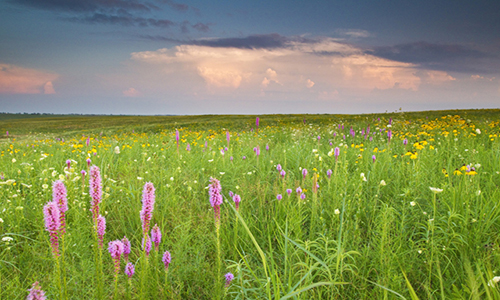The Prairie Days celebration is June 24-25 at Dunn Ranch and Pawnee Prairie in Harrison County. Gazing at native wildflowers and grasses waving in the wind on a summer day, it’s easy to remember that these prairies are small remnants of grasslands and grassy wooded areas that once dominated the state’s hills and valleys, especially in northwest Missouri. The history is as colorful as the ecology that produced some of the world’s richest farming soils, a valuable trait that contributed to the scarcity of unplowed prairie today.
But biologists, naturalists, and farmers see an important future for prairie plants and creatures in agriculture, scientific research, and conservation of rare or unusual species. For example, Missouri Department of Conservation (MDC) staff will discuss grazing nutrition at Prairie Days. The Nature Conservancy, which owns Dunn Ranch, will give tours of their bison herd. Experts will also have displays and give talks or tours on prairie plant identification, prairie reptiles, and amphibians, pollinators such as butterflies and bees, mammals, and the unique qualities of prairie headwater streams.
Prairie Days kicks off with a social and mixer 9 to 11 p.m. on Friday, June 24, at Dunn Ranch Prairie headquarters, 16970 W. 150th St., Hatfield, Mo. The ranch is located west of Eagleville and accessed off Interstate 35 via Route M. “Green Fire,” a documentary film about legendary conservationist Aldo Leopold, will be shown.
A guided bird hike is offered at MDC’s Pawnee Prairie Natural Area 5:30 to 7:30 a.m. on Saturday, June 25. This unplowed prairie remnant also has diverse wildflowers and native warm-season grasses.
The other tours and exhibits will be from 8 a.m. to 3:00 p.m. at Dunn Ranch. Concessions will be available. All activities are free. No prior registration is required. All ages are welcome.
Pawnee Prairie and Dunn Ranch Prairie are part of a broader public and private partnership to enhance prairie species in the Grand River Grasslands. The effort extends north into Iowa with programs such as habitat management to boost prairie chickens, which are endangered in Missouri and Iowa. Prairie chickens are colorful and unique birds. But their presence also indicates a healthy grassland ecosystem that supports many native species. Grasslands have a role in agriculture’s future, too.
For example, native grasses and wildflowers offer nutritional value to cattle but also plentiful forage in the hot and dry summer months when growth slows for non-native, cool-season grasses. MDC staff works with private landowners to restore native species to grazing systems.
“When it’s dry and hot, the warm-season grasses are growing because they have deep roots in the soil,” said Kendall Coleman, MDC private land conservationist. “The cattle can get good weight gain in summer, and the cool-season grass pastures can get a rest from grazing, this benefits both grass and the grazer.”
Deep-rooted prairie plants create a soil system that soaks up rainwater like a sponge, recharging groundwater that feeds wells, seeps, and springs, Coleman said. Well-managed grasslands can improve water quality in streams that serve communities.
Unplowed prairies are very diverse and highly productive. Scientists are studying the synergy between prairie plants, soil bacteria and pollinator insects for models that can provide economic boosts for agriculture. Prairie plants are adapted to local soils and climate, and they include a wide variety of species such as native cool-season grasses and legumes. Research on possible uses for these plants has grown in recent decades.
Beauty and history alone are good reasons to conserve and restore prairies. Economic value for grazing and haying is already part of the past, present, and future. But modern science is likely to unlock more uses for plants and biologic relationships between prairie species.
For more information on Prairie Days, call the MDC Northwest Regional Office at 816-271-3100. MDC, The Nature Conservancy, and the Missouri Prairie Foundation are partners in hosting the event, with help from volunteers committed to conservation.






